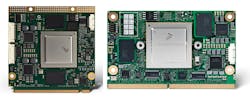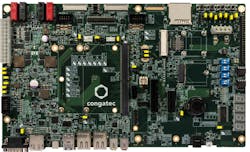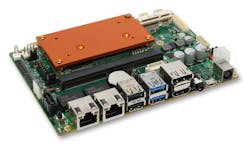An Ecosystem for Vision, AI, and Countless Other Applications
With the i.MX 8 series, NXP brought to market a new family of application processors that offers ultra-wide scalability based on the Arm Cortex-A53 and A35 core architectures. To date, the processor family has six members, ranging from high-performance i.MX 8 to cost-optimized i.MX 8X variants. Recently, they became available on several SMARC and Qseven modules in a number of variants (Fig. 1). They’re based on the i.MX 8, i.MX 8X, and new i.MX 8M Mini processors, which specifically target embedded applications.
Flagship Processors of the Arm Ecosystem
Leading all NXP i.MX 8 variants without the 8X suffix is the ARMv8-A based 64-bit ARM Cortex-A53 architecture, which provides up to 60% more performance than its Cortex-A7 predecessor. It also offers improved power management for minimum heat generation and maximum battery life in mobile applications.
The leading X-variant is the Cortex-A35 architecture, which delivers up to 40% more performance compared to Cortex-7-based systems. Even when comparing it to the A53 options, the A35 architecture offers advantages such as a smaller footprint and lower price. For memory-intensive workloads, the computing performance is comparable—even for integer workloads, 84-85% performance is achieved. These and other benefits make the A53 and A35 cores currently the most attractive application processors in the Arm ecosystem.
Core Complexes in Multiple Configurations
Correspondingly, NXP has made the cores available in numerous i.MX 8 chip variants with different, so-called “core complexes.” Depending on the application area, additional cores are added, such as the high-performance A72, which features out-of-order execution unlike the A53. As a result, the A72 achieves 6.35 DMIPS/MHz, which is almost 3X the computing power per megahertz of the A53 with 2.24 DMIPS/MHz. Hardware-virtualized platforms are top candidates to take advantage of such power.
Other areas where the individual processor series and variants differ include the integrated graphics units, the number of integrated M4F MCUs for I/O functions, as well as signal control and processing. M4F also takes over system monitoring when the Cortex-A cores are switched off to save energy. The most attractive core complexes for embedded-computing applications are essentially the i.MX 8 variants without suffix, as well as those with the suffixes 8M Mini and 8X, where performance is becoming increasingly lean.
High-End Systems with 4K Graphics
SMARC and Qseven modules with i.MX 8 are based on the i.MX 8QuadMax, 8QuadPlus, and 8DualMax processors. Next to four A53 cores, the QuadMax also has two Arm Cortex-A72 high-performance cores; the 8QuadPlus has one A72. The i.MX 8DualMax processor, on the other hand, completely dispenses with the A53 cores in exchange for two A72 cores.
With two GC7000 graphics units (1x for the i.MX 8 DualMax), they offer advanced graphics capabilities for up to three independent 1080p displays or a single 4K monitor. SMARC and Qseven computer-on-modules (COMs) already offer application-ready HDMI 2.0 support with HDCP 2.2, 2x LVDS, and 1x eDP 1.4. Support is further provided for the Vulkan interface as well as OpenCL, OpenGL, and OpenVX—the latter graphic support is especially apt for embedded real-time use cases. Applications include face, body and gesture tracking, smart video surveillance, advanced driver-assistance systems (ADAS), object and scene reconstruction, augmented reality, visual inspection, or robotics.
Numerous additional features make these COMs extremely powerful and flexible. The list includes 2x GbE with optional IEEE1588 Precision Time Protocol support, up to 6x USB including 1x USB 3.1, up to 2x PCIe Gen 3.0, 1x SATA 3.0, 2x CAN bus, 4x UART, as well as an optional onboard Wi‑Fi/Bluetooth module with Wi-Fi 802.11 b/g/n and BLE as well as two MIPI CSI-2 video inputs.
Low-End Systems for Cost-Sensitive Apps
With their Arm Cortex-A35 cores, the SMARC and Qseven COMs with Cortex-A35-based NXP i.MX 8X variants are energy- and cost-saving champions. They’re reduced to a GC7000 graphics unit with or without video acceleration, and an M4F I/O controller. Nevertheless, they offer an outstanding feature set in the 2- to 4-W embedded computing class with support for two displays via 1x dual-channel LVDS, 2x MIPI-DSI, or HDMI 1.3. For the other I/Os, there are only two differences: The modules with i.MX 8X offer one instead of two PCIe Gen 3.0 lanes, and one instead of two MIPI-CSI camera inputs.
Otherwise, the feature set including IEEE 1588-compliant real-time Ethernet support is largely comparable. The spectrum of i.MX 8X uses therefore ranges from IoT-connected devices in outdoor and mobile vehicle applications, to industrial IIoT and Industry 4.0 devices, machines, and systems with hardware-based virtualization.
Industrial and IoT Systems for Universal Use
In the mid-range, the 8M Mini variants offer an energy-saving design of the A53 cores with 14-nm FinFet microarchitecture, different from the high-end processors without suffix. Thanks to the more efficient 14-nm structure, they maintain a maximum clock rate of 1.8 GHz for high performance with optimized power consumption.
According to NXP, the broadly scalable i.MX 8M Mini family with single-, dual- and quad-core processors can be used universally in all industrial and IoT applications where the feature set of the less-powerful i.MX 8M Nano variants falls short. Significant benefits of the i.MX8 M Mini include the generic PCIe support, which on SMARC COMs is used to support the standard feature set of this specification next to video decode and encode functions.
From high-end low-power systems with high-resolution 3D graphics to broadly scalable mid-range systems and ultra-energy-efficient 2-W systems, the NXP i.MX 8 family offers countless possibilities supported by application-ready COM ecosystems.
Reaching Goals Faster, Cheaper and More Sustainably
Computer-on-module standards such as SMARC and Qseven act as a kind of glue logic between the application and the actual hardware components. OEMs also benefit from software compatibility that extends far beyond individual processor families.
Since APIs are identical for different processor generations and manufacturers, specific hardware interfaces can be handled in a uniform way. This accelerates time-to-market, simplifies OEM documentation, and ensures sustainable scalability to support the next product, regardless of the processor manufacturer. In short, they are ideal conditions to test the universal applicability of the i.MX8 portfolio.
Eval Platforms with a Rich Feature Set
Evaluation carrier boards are widely available for this purpose (Fig. 2). Supporting the entire feature set of potential options for each of the standards, they’re provided as application-ready starter kits that include everything needed. Carrier-board solutions based on recognized embedded motherboard and single-board computer standards are becoming increasingly attractive as well. They also meet all requirements for field deployment, as they can be easily fitted within the appropriate housing and then certified as systems.
SMARC-Based 3.5-in. Boards
One example is the 3.5-in. board (146 × 102 mm) conga-SMC1 (Fig. 3). It features the interfaces defined by the SMARC 2.1 standard, including dual GbE, USB and USB hub support, SATA 3 for external hard drives or SSDs, and UART, 2x CAN, 8x GPIO, I2C, SPI, and I2S sound.
For specific expansions, the board offers a miniPCIe slot as well as an M.2 Type E E2230 slot with I2S, PCIe, and USB, and an M.2 Type B B2242/2280 with 2x PCIe and 1x USB. An integrated MicroSim slot for IoT connection is also provided. Displays can be connected via HDMI, LVDS/eDP/DP, and MIPI-DSI. The board further offers two MIPI-CSI inputs for camera connection, which are also part of the standard. The new SMARC 2.1 standard even adds two more MIPI CSI ports that are backwards-compatible to SMARC 2.0.
Such carrier boards can be equipped extremely flexibly with any of the i.MX 8-based available modules. Variants that don’t require all interfaces can be produced in comparatively small quantities using identical PCBs but a slimmer bill-of-materials (BOM). Functionality is narrowed down to the exact scope of the respective module, making it possible to provide industrial-grade batches at any time.
Easy Camera Integration
Especially beneficial are carrier boards that already feature two MIPI-CSI inputs with flat foil connectors, which means that any MIPI camera can be integrated directly and without additional hardware.
The power of Arm-based vision platforms was already demonstrated by an application-ready retail kit from congatec, Basler, and NXP, which uses artificial intelligence to recognize products without the need for bar or QR codes. Items are detected in real time via the video stream supplied by the camera that’s integrated in the i.MX 8-based COM used on site. The system is so powerful that it doesn’t require a cloud connection, unlike all current voice assistants, which still need a permanent connection for voice recognition.
Integrating the Right Wireless Solution
Many applications other than complex AI and vision also require wireless connectivity. This can be integrated either directly on some SMARC modules or on the carrier board. However, a standard version is designed to meet maximum requirements.
In most cases, OEMs will only require a very specific feature set that’s as cost-and energy-efficient as possible. To achieve this, embedded vendors like congatec also help customers find and integrate the right wireless solution for the specific application in terms of throughput, functionality, cost, and compatibility.
Covering Security Concerns
Security is just another increasingly important issue: The data and functional security of i.MX 8-based devices is best ensured via High Assurance Boot (HAB). HAB allows only authenticated software to be executed on the ARM device. Not only is this important for IoT-connected devices, but also particularly for all security-critical applications in the healthcare and eGovernment sector, where sensitive personal data needs protecting at all costs. As BSI certification is often required for such use cases, OEMs should look for vendors who provide its customers with appropriate firmware and software support in addition to extensive documentation.
Bootable Off-the-Shelf
To be able to start their evaluations directly, Arm developers also need comprehensive software support, such as board support packages with a suitably configured bootloader, appropriately compiled Linux, Yocto, and Android images, and all necessary drivers. Precompiled binaries provided by congatec on GitHub integrate all of these components. Using Arm-based modules, developers can therefore get started just as easily as they would in the Windows world.
Immediately Integration-Ready
With the new i.MX 8-based SMARC and Qseven modules, developers of highly integrated IIoT and embedded vision applications can reach the next technology level quickly and easily. That’s because they can integrate a credit-card-sized off-the-shelf module into their applications immediately and with minimal space requirements. Starter kits and application-ready boards, such as the 3.5-in. SBC from congatec, are components of the comprehensive i.MX 8 ecosystem of products and services. With low NRE costs, they help accelerate evaluation and market introduction of this brand-new processor architecture, which will open up many new application fields such as industrial real-time applications and vision-based AI.
Deep Learning Starter Kit for Retail Apps
Basler, congatec, and NXP have jointly developed a MIPI-CSI 2 camera-based Deep Learning starter kit (Fig. 4) for the retail sector. It illustrates the range of possibilities that vision technologies bring to embedded applications and how they can simplify our daily life.
Trained with a neural network and similar to face recognition, the system recognizes items in a shopping cart on the basis of a video stream to work out and display the final bill. Such systems open new perspectives for retail applications: They make it very easy to add products to the range of goods on offer, as they can be integrated using training with neural networks or even sparse modeling.
Retailers benefit from lower labor costs and an improved shopping experience through instant checkouts, shorter queues, and 100% checkout capacity at all times—even when the store is open 24/7. The system is based on a Basler embedded vision kit with an NXP i.MX 8QuadMax SoC running on congatec’s conga-SMX8 SMARC 2.0 COM, a SMARC 2.0 carrier board, and Basler’s dart BCON camera module for MIPI 13 MP.
Dan Demers is Director, Sales & Marketing, at congatec Americas.
About the Author
Dan Demers
Director of Sales & Marketing – Americas, congatec
Dan Demers holds a B.B.S degree in International Business from Grand Valley State University, Grand Rapids, Michigan and an M.B.A. from Ashford University, Clinton, Iowa. Mr. Demers has over 22 years of experience in embedded computing, having worked with Fortune 500 companies in the industrial, medical, and communications markets.




